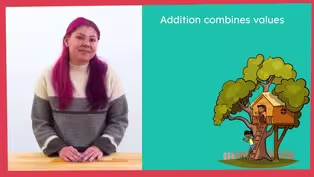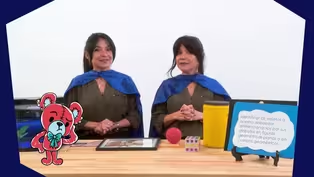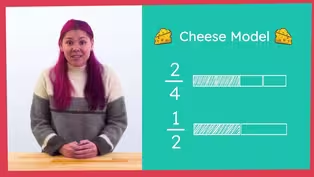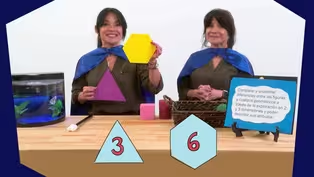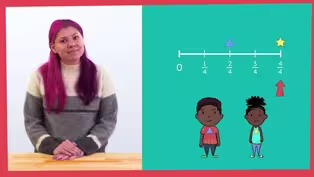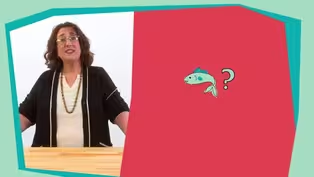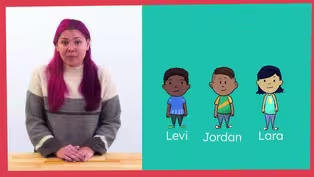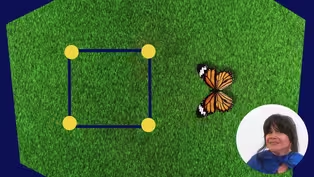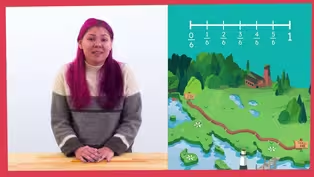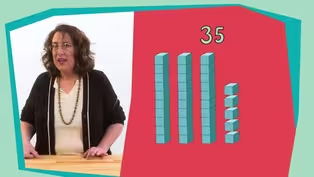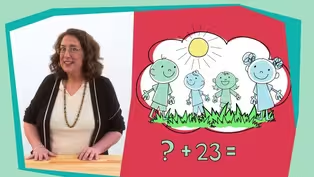
Episode 41 | Math Lessons
5/10/2021 | 28m 46sVideo has Closed Captions
Math lessons for early learners, led by NC teachers.
The first lesson (aimed at PreK-K) teaches early learners how to describe an object’s measurable attributes. The second lesson (aimed at 1st-2nd graders) teaches students how to solve addition and subtraction word problems. Classroom Connection is your At-Home Learning companion where children love to learn. All lessons are led by NC educators.
Problems playing video? | Closed Captioning Feedback
Problems playing video? | Closed Captioning Feedback
At-Home Learning Presents: Classroom Connection is a local public television program presented by PBS NC

Episode 41 | Math Lessons
5/10/2021 | 28m 46sVideo has Closed Captions
The first lesson (aimed at PreK-K) teaches early learners how to describe an object’s measurable attributes. The second lesson (aimed at 1st-2nd graders) teaches students how to solve addition and subtraction word problems. Classroom Connection is your At-Home Learning companion where children love to learn. All lessons are led by NC educators.
Problems playing video? | Closed Captioning Feedback
How to Watch At-Home Learning Presents: Classroom Connection
At-Home Learning Presents: Classroom Connection is available to stream on pbs.org and the free PBS App, available on iPhone, Apple TV, Android TV, Android smartphones, Amazon Fire TV, Amazon Fire Tablet, Roku, Samsung Smart TV, and Vizio.
Providing Support for PBS.org
Learn Moreabout PBS online sponsorshipMore from This Collection
Math lessons for early learners, led by NC teachers.
Video has Closed Captions
Math lessons for early learners, led by NC teachers. (28m 46s)
Video has Closed Captions
Math lessons for early learners, led by NC teachers. (28m 46s)
Video has Closed Captions
Math lessons for early learners, led by NC teachers. (28m 46s)
Video has Closed Captions
Math lessons for early learners, led by NC teachers. (28m 46s)
Video has Closed Captions
Math lessons for early learners, led by NC teachers. (28m 46s)
Video has Closed Captions
Math lessons for early learners, led by NC teachers. (28m 46s)
Video has Closed Captions
Math lessons for early learners, led by NC teachers. (28m 46s)
Video has Closed Captions
Math lessons for early learners, led by NC teachers. (28m 46s)
Video has Closed Captions
Math lessons for early learners, led by NC teachers. (28m 45s)
Video has Closed Captions
Math lessons for early learners, led by NC teachers. (28m 46s)
Video has Closed Captions
Math lessons for early learners, led by NC teachers. (28m 45s)
Video has Closed Captions
Math lessons for early learners, led by NC teachers. (28m 46s)
Providing Support for PBS.org
Learn Moreabout PBS online sponsorship[cheerful upbeat music] ♪ ♪ Hey, my name is Mr. R and I came to say ♪ ♪ I love "Classroom Connection" in a major way ♪ - What's up, my super learners?
And welcome to another day to do some super learning.
How's everybody doing?
Let's see them thumbs up.
There it is.
I like to see that!
Now, what's the best thing you can do while inside?
Learn something cool with that super learning mind.
Yo, check this out!
- Hello, super learners.
I'm Ms. L and I am so glad you're joining me today.
Are you ready for a math adventure?
Well, let's get started with a song!
Ready?
♪ Hello, super learners ♪ ♪ How are you ♪ ♪ Hello, super learners ♪ ♪ How are you ♪ ♪ I'm so glad you're here today ♪ ♪ And I hope you feel the same ♪ ♪ Hello, super learners ♪ ♪ How are you ♪ I feel so great today and I really hope you do too.
You know, now it's time for some math power warmups, counting to 20.
Are you ready?
Here we go!
Ready?
[air whooshes] ♪ One, two, three, four ♪ ♪ Five, six, seven, eight ♪ ♪ Nine, 10 ♪ ♪ 11, 12 ♪ ♪ 13, 14, 15 ♪ ♪ 16, 17, 18 ♪ ♪ 19, 20 ♪ ♪ That was fun ♪ Awesome job!
Now let's count to 10, to 20 actually, one more time.
But we're gonna snap count, okay?
We're counting to 20 while snapping.
One [snaps], two [snaps], three [snapping], four [snaps], five [snaps], six [snapping], seven [snaps], eight [snaps], nine [snapping], 10 [snaps], let's keep going, 11 [snaps], 12 [snaps], 13 [snapping], 14 [snaps], 15 [snaps], 16 [snapping], 17 [snaps], 18 [snaps], 19 [snapping], 20 [snaps].
Yes, super learners are the best!
Great job, super learners!
I'm getting warmed up.
I hope you are too.
How about one more time counting to 20, but this time, let's do it in Spanish.
Ready?
[speaking in Spanish] We made it to 20!
Awesome job!
You know, we have counted to 20 three different ways.
Now it's time to review our colors.
Let's say them in English and in Spanish, okay?
Ready?
[speaking in Spanish] Red, [speaking in Spanish] orange, [speaking in Spanish] yellow, [speaking in Spanish] green, [speaking in Spanish] blue, [speaking in Spanish] purple, [speaking in Spanish] brown, [speaking in Spanish] black, [speaking in Spanish] white, [speaking in Spanish] gray.
Look for these colors in the world today!
Wow, we did that in English and in Spanish.
So we have one more warmup.
Let's play the shapes game.
Can you help me?
You'll see a shape, and then you say its name, and you can say it in English or in Spanish.
Here we go.
[speaking in Spanish] Square, [speaking in Spanish] circle, [speaking in Spanish] triangle, [speaking in Spanish] rectangle, [speaking in Spanish] rhombus, [speaking in Spanish] trapezoid, [speaking in Spanish] hexagon, [speaking in Spanish] cube, [speaking in Spanish] cone, [speaking in Spanish] cylinder, [speaking in Spanish] sphere.
Wow, we did all of our shapes!
Are you all warmed up?
I am!
Then it's time for our math mission of the day!
Awesome!
We're gonna check in with Sparkles the Fish to see what our mission is today.
Let's see.
[gasps] Sparkles, there you are.
What mission do you have for us?
Oh, I can't wait to read it!
Let's see what our math mission is.
Wow.
Okay.
[gentle chiming music] This says: Dear Super Learners, Your mission today is to use your math skills to measure and to set the perfect [gasps] party for my birthday.
Oh my goodness, it's Sparkles' birthday.
Wow!
Happy birthday, Sparkles!
Well, super learners, I know we can do this.
We can definitely do this mission, and I know we can plan the perfect party for Sparkles.
We gotta get our capes on and get ready.
Let me grab my cape.
Can you put your invisible cape on?
Let's see.
I love my cape.
Every time I wear this cape, I feel like I can do any math mission, especially with your help!
Ready?
Capes on, math power up!
Let's go!
[gasps] Well, hey!
Here's our first mission.
Come in and look closer.
This asks that we find the perfect birthday banner for Sparkles' tank.
Here we have three banners that say happy birthday.
Each banner is beautifully different.
Will you help me choose the perfect banner for Sparkles' tank?
Great!
Thank you!
So I wonder, which one should we choose?
Hmm.
We don't want one that's too big or too small.
We can compare the banners to help us decide which one is right for Sparkles' birthday.
We have three different sizes and different colors.
Sparkles shared with us that in our mission, we will be using our math powers to measure.
So I wonder what we can measure here, hmm, to help us choose the best banner.
[gasps] I know!
We can measure the different colors?
No, no, no.
We cannot measure colors.
But we can measure their sizes!
We can measure the size of the banners.
We can compare the banners to measure which banner is the right size.
We don't want one that's too long.
We need one to fit perfectly.
A Sparkles-sized banner, one that's small.
So, an easy way to measure is to actually line up the ends of objects.
This way we can have an accurate measurement of which one is the shortest and which one is the longest.
So, let's line up the ends of our banners, okay?
Let's line them up.
We'll have our end point right here.
So we need them all to line up together.
See how this one starts here, and then the next one, and then here's the next one.
Here's banner A, banner B, and banner C. Now that we have our banners lined up, we can see which banner would measure to be the shortest.
We want one short and small for Sparkles.
So super learners, which looks to be the shortest banner?
Do you think it's banner A, B, or C?
Which one is the shortest?
[gasps] It's B, you're right!
Banner B is the shortest.
Let's see how banner B looks on Sparkles' tank.
It looks like the perfect size.
[gaps] Oh my goodness.
Sparkles, what do you think about your birthday banner?
I love it, too.
It looks perfect!
Thank you for your help.
Super learners, we comparatively measured each of the banners.
We compared them to each other.
We did it.
Awesome job!
[air whooshes] Our math mission next is to compare again and measure.
And actually, this one is to choose a surprise gift for Sparkles.
So I have a surprise gift in mind, but I really need your help figuring out which box I should use.
Each box is different.
Different patterns, different sizes.
We see that this one has polka dots and this one has stripes.
But both boxes are cubes.
Hmm.
Let's use our math powers to measure these boxes and choose the best one for Sparkles.
Remember from earlier, we learned that we can measure some things but not everything.
So, I wonder what we can measure here to help us choose the best box.
[tongue clicking] [gasps] Yes!
We can compare and measure the sizes like we did for the banners.
We can compare the sizes of the boxes.
So let's see which one is big and which one is small.
We know an easy way to measure is to line up the ends of objects.
This way we have an accurate measurement of which one is tall and which one is short.
So, we'll begin by placing these side by side on the table.
Oh, now they're on the same level so we can see now which one is tall and which is short.
So can you, super learner, can you point to the tall box?
Which one looks to be tall?
And now can you point to the short box?
Which one looks to be short to you?
Yes!
This one is the tall one and this one is the short one.
Awesome job.
Putting them on the same level allows us to see which one is tall and which is short.
So now my question is, which should we give to Sparkles?
I'm gonna make a gift and put it inside.
Do you think we should put the gift in the big one or the small one?
[gasps] I think the big one too!
I love the big polka dots.
Thank you for your help.
I think we have completed this mission.
But first we need to check back with Sparkles.
Let's see, Sparkles.
Have we completed the mission?
[water bubbling] We did?
Awesome!
We completed the mission!
We used our math tools to observe and measure, and planned the perfect party.
Now it's time to set everything up!
All right.
Our banner, perfect, thanks to you, super learners.
And now let's bring over our box.
What do you think about the polka dots, Sparkles?
Sparkles loves the big polka dots.
Thank you, super learners, for helping make Sparkles' birthday so special.
You used your math powers and you completed the mission.
So now what is it time to do?
Review, review!
That's right.
Let's look back.
We can now compare and now we can describe measurable attributes of objects like tall and short.
We can use measurement words to describe things like heavy, light, long, tall, short, big, small.
There are so many words we can use.
So practice comparing objects and using these words today to describe objects in the world around you.
You can share your math power by showing it to someone.
Thank you, super learners, for going on a math mission with me today, and Sparkles thanks you too.
Happy birthday, Sparkles!
Remember, super learners, you have the power to be super at math.
Adios!
Bye!
[air whooshes] - Okay.
I got a joke for you.
Why did the kid bring a ladder to school?
Because she wanted to go to high school.
[kids booing] What?
Don't you boo me!
Just give me another chance.
Maybe I'll have a better joke for you after this next video.
[chill music] [bright guitar music] - [Kids] "Lalo's Lunchbox!"
- Hello, friends.
My name is Lalo!
My lunchbox just gave us a ton of London muffins.
- These will make great pizzas.
- Absolutely!
- I wonder what kind of toppings we should have on the pizzas.
[air whistling] [Lalo pops] - That was odd!
[Lalo pops] - Wowzers!
Lunchbox, did you just teleport me into a garden?
[lunchbox rattles] [laughs] Yeah, you're right!
This would be a great place to find pizza toppings.
- [Imogen] Hello.
- Oh, hello.
- Hello.
- Welcome to the Urban Roots Garden.
My name is Imogen.
- I'm Tony.
- Oh, well, nice to meet you, Tony and Imogen.
Oh, my name is Lalo.
- So what brings you here?
- Oh, well, my lunchbox and I just popped in to look for toppings to put on pizzas.
What kind of plants grow here?
- [Imogen] We have some lettuce growing here and some cucumbers and some peppers.
- Those would be awesome to have on pizzas.
So what plants are these?
- [Imogen] That's basil, - Basil!
Oh, basil is super fun because you can just pick off a leaf and eat one.
Mm!
And they have this sweet, zesty flavor which is great for pizzas.
- Our basil's growing very well this season.
Would you like to bring a basil plant for your pizza?
- Oh, that'd be wonderful.
Thank you, Tony.
You know, my lunchbox and I should probably be getting back now.
- Well, feel free to come back to our Urban Roots Garden at any time.
- Oh, I will!
Thanks!
[air whistling] [Lalo pops] - Where did he- - Where did he go?
- Where did they go?
When will they get back?
How do they get back?
- Try calling Lalo's cellphone.
- You kidding me?
He doesn't have a cell.
[screams] - Hello, Daisy.
Freddie.
My lunch box just popped me over to Urban Roots where they gave us their excess basil to use for our pizzas.
- Basil is perfect for pizzas!
- Yeah!
[playful guitar music] [soft rhythmic music] - [Narrator] Let's count in Kiswahili.
One.
[kids speaking in Kiswahili] [narrator speaking in Kiswahili] Two.
[kids speaking in Kiswahili] [narrator speaking in Kiswahili] Three.
[kids speaking in Kiswahili] [narrator speaking in Kiswahili] Four.
[kids speaking in Kiswahili] [narrator speaking in Kiswahili] Five.
[kids speaking in Kiswahili] [narrator speaking in Kiswahili] Six.
[kids speaking in Kiswahili] [narrator speaking in Kiswahili] Seven.
[kids speaking in Kiswahili] [narrator speaking in Kiswahili] Eight.
[kids speaking in Kiswahili] [narrator speaking in Kiswahili] Nine.
[kids speaking in Kiswahili] [narrator speaking in Kiswahili] Ten.
[kids speaking in Kiswahili] [narrator speaking in Kiswahili] [upbeat music] [man singing in Kiswahili] [people singing in Kiswahili] [child speaking in Kiswahili] [child giggles] - Okay.
I have another joke for you.
What do you call a dog magician?
A labra-cadabra-dor!
[laughs] I actually love saying that.
I thought that was pretty good.
Alright.
Let's check out the next video.
[chill music] - Hi, friends.
My name is Dawn.
[text popping] Splat and I are so happy to be here with you today.
[electronic beeping] Today we are going to solve a problem about peaches.
I love peaches.
Before we begin, let's take some time to get a few supplies.
[cat meows] Maybe you want to go and get something to write with, and some paper, [paper rustling] and a stuffed animal or a trusted adult to talk to.
I'll wait for you to gather what you need.
[air whooshes] [bright music] Welcome back!
Let's get started.
In our math story today, my friend Moesha also loves peaches.
She loves them so much that she goes out and picks them with her mom, and her mom helps too.
Here is a picture of Moesha's peaches.
[air whooshing] Today we are going to read a mathematical story about Moesha and some peaches that she and her mom have collected and put on the table.
Before we get started though, let's exercise our brain and get it ready to do some math work so we can be fit mathematicians.
[air whooshing] Will you come join me?
[air whooshing] Let's stand up and do three handclaps.
Are you ready?
One [claps], two [claps], three [claps].
Nice job!
Now let's do four more handclaps.
One [claps], two [claps], three [claps], four [claps].
Great job clapping.
So we started with three handclaps and then we did four more handclaps.
So how many did we do altogether?
That's right, we did seven!
Because three handclaps plus four handclaps equal seven handclaps.
Now, let's stay standing up and together let's do two jumping jacks.
Are you ready?
One, two.
Nice job!
Now let's do one more jumping jack.
One.
Great work!
So we started with two jumping jacks and then we did one more, so we did three jumping jacks in all.
Wow!
I feel really energized and ready to focus on helping Moesha figure out how many peaches she has.
Your job today is going to be to figure out how many peaches Moesha's mom puts on the table.
I am so excited to do this with you, and then read a little to find out about Moesha and her peaches.
[air whooshes] Moesha has some peaches on the table.
Her mom puts more peaches on the table.
There are now even more peaches on the table.
What are you picturing in your mind?
Will you tell a friend or trusted adult what you are picturing?
[gentle music] Hmm.
I'm picturing Moesha with peaches on the table.
I also see her mom putting more peaches on the table.
Now I see Moesha with even more peaches than she started with on the table.
Let's read a little more about Moesha.
Moesha has four peaches on the table.
Her mom puts more peaches on the table.
There are now even more peaches on the table!
What do we know now that we didn't know before?
You're exactly right!
We now know that Moesha has four peaches on her table.
How many peaches do you think that her mom could have put on the table?
Hmm.
I wonder.
Splat, he says her mom could have put two or four or seven peaches on the table.
Let's keep reading.
Moesha has four peaches on the table.
Her mom puts more peaches on the table.
Now there are 13 peaches on the table.
What do we know that we didn't know before?
You are so right!
We know that Moesha started with four peaches and now has a total of 13 peaches on her table.
What question could we ask about this story?
Think of a question about Moesha and her mom putting peaches on the table, and then whisper it back to Splat and me.
[gentle guitar music] I'm listening in for the whispers!
I hear a whisper that says we could ask how many peaches did Moesha's mom put on the table?
That is a great question.
Splat says we can ask who put more peaches on the table: Moesha or her mom?
Nice question, Splat.
Let's read a little more about Moesha and see if we can figure out the question.
Moesha has four peaches on the table.
Her mom put more peaches on the table.
Now there are 13 peaches on her table.
How many peaches did Moesha's mom put on the table?
What is the question in this story asking us?
Yes, you're right!
The question is asking, how many peaches did mom put on the table?
Can you answer this question?
Do we have all the information we need to answer that question?
[bright music] Yes, you do have all the information you need!
I want you to think about how you can solve this problem.
Will you tell a trusted adult or even a stuffed animal how you would solve this problem?
I hear some great answers.
Splat always helps me solve math stories, and Splat just told me that a way I can solve this problem is through a tool called an open number line.
Let's try it out.
You can even do this on your own paper if you want to.
Hmm.
Moesha has four peaches on her table.
So we will draw a line and begin with the number four.
Then her mom puts more peaches on the table and now there are 13.
So we write 13 at the end of the number line.
Let's count up from four to 13 to find out how many peaches Moesha's mom put on the table.
We will make humps each time we count.
Count with me.
We'll begin at four.
Five, six, seven, eight, nine, 10, 11, 12, 13.
Hmm.
I wonder how many times we hopped from the number four to stopping at 13.
Do you know how many times we hopped?
Tell a friend or a stuffed animal.
All right.
Let's count the hops to see if your prediction was correct.
This will tell us how many peaches Moesha's mom put on the table.
The hops are the number of peaches Moesha's mom put on the table.
Let's get ready to count.
One, two, three, four, five, six, seven, eight, nine.
Great job, friends!
Nine hops.
That means Moesha's mom gave her nine peaches.
That was really great work on the number line.
In just a bit, we will solve this problem using another strategy.
But first, let's take a math movement break to give our brains a rest.
Let's stand up, and follow me.
We're going to exercise our numbers, counting down from 10.
Are you ready to move your body to each number?
Let's go!
First, let's do 10 twists.
One, two, three, four, five, six, seven, eight, nine, 10.
Next, let's do nine hops.
One, two, three, four, five, six, seven, eight, nine.
Great job.
Next is eight arm circles.
Ready?
One, two, three, four, five, six, seven, eight.
Now we're going to do 7 knee bends.
One, two, three, four, five, six, seven.
Next is six arm stretches.
One, two, three, four, five, six.
Next up is five knee raises.
One, two, three, four, five.
Let's do four side bends.
One, two, three, four.
Let's do three toe raises.
One, two, three.
Let's do two head nods.
One, two.
And finally, let's do one big jump.
One.
Whoo, that was fun exercising our math minds by counting down from 10.
Now that we're energized, Splat and I will show you another way to solve our problem.
Remember our problem is Moesha has four peaches on her table.
Her mom puts some more peaches on her table.
Now there are 13 peaches.
How many peaches did her mom add to the table?
Splat says another way to solve this problem would be to use a 10 frame.
He's right!
To do this, we would add four counters to a 10 frame because that's how many peaches Moesha started with.
Then, we would add more counters until we get to 13 because we know that Moesha had 13 peaches in all.
Next, we count how many counters we added to find out how many peaches Moesha's mom added to the table.
Let's count together.
One, two, three, four, five, six, seven, eight, nine.
She added nine more peaches to the table.
So if we were to write an equation to match our number line and 10 frames, it could be 4 + 9 = 13, because Moesha started with four peaches, her mom added nine peaches, and then they had 13 peaches in all.
That is great reasoning with numbers.
Splat and I have to be going soon, but before we go, we would love to hear you talk about what you learned today.
I have these sentence starters that we can use to help us talk about our learning.
They say, "Today I learned," and "I can."
So if I were going to talk, I'd say, "Today I learned how to find a missing number in a math story.
I can use a number line and 10 frames to figure out missing numbers in a math story."
Now it's your turn.
Let's read together and you can finish the sentence.
Today I learned... [soft music] Great thinking about what you learned.
Our next sentence starter is "I can."
You did a great job talking about your math learning!
You also did such a great job of solving the mathematical story of how many peaches Moesha's mom gave her.
We used an open number line and a double 10 frame to solve the amount of peaches Moesha's mom put on the table.
Mathematicians, you worked very hard figuring out the peaches Moesha's mom added to the table.
Splat and I have to go now.
We hope you enjoyed today and we hope we get to see you soon.
[bright music] [air whooshes] - Hi, I'm Benjamin Carlson and 11 years old.
And this is my favorite joke.
[drum rattling] What day of the week are most twins born on?
Twos-day!
- All right.
Everyone, our time has come to an end for today.
Another great day of learning under our belts.
Be cool, be courageous, and be kind.
And don't forget: peace, love, and learning.
Bye!
[cheerful upbeat music] ♪


- Home and How To

Hit the road in a classic car for a tour through Great Britain with two antiques experts.












Support for PBS provided by:
At-Home Learning Presents: Classroom Connection is a local public television program presented by PBS NC
